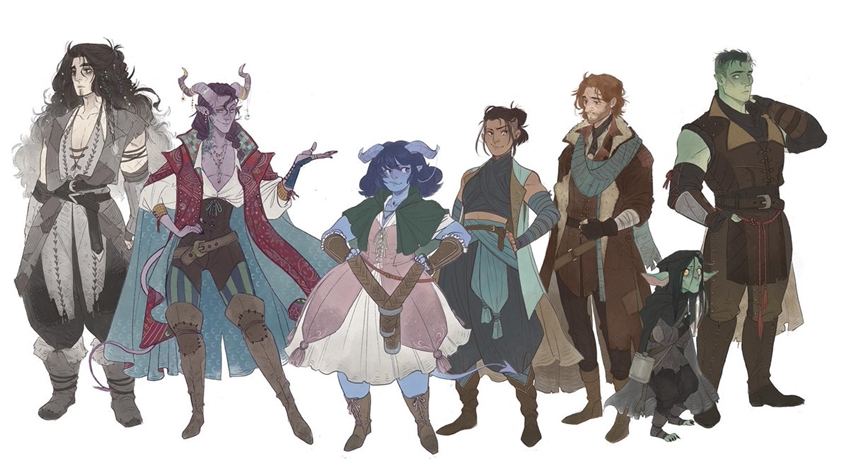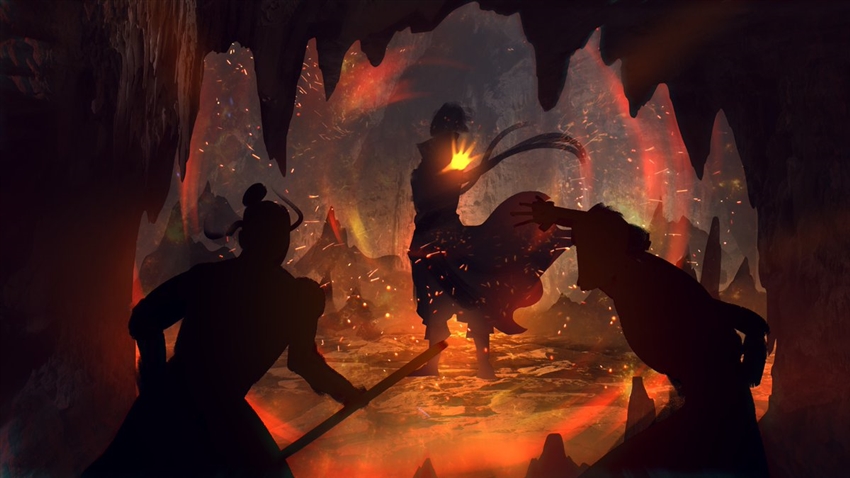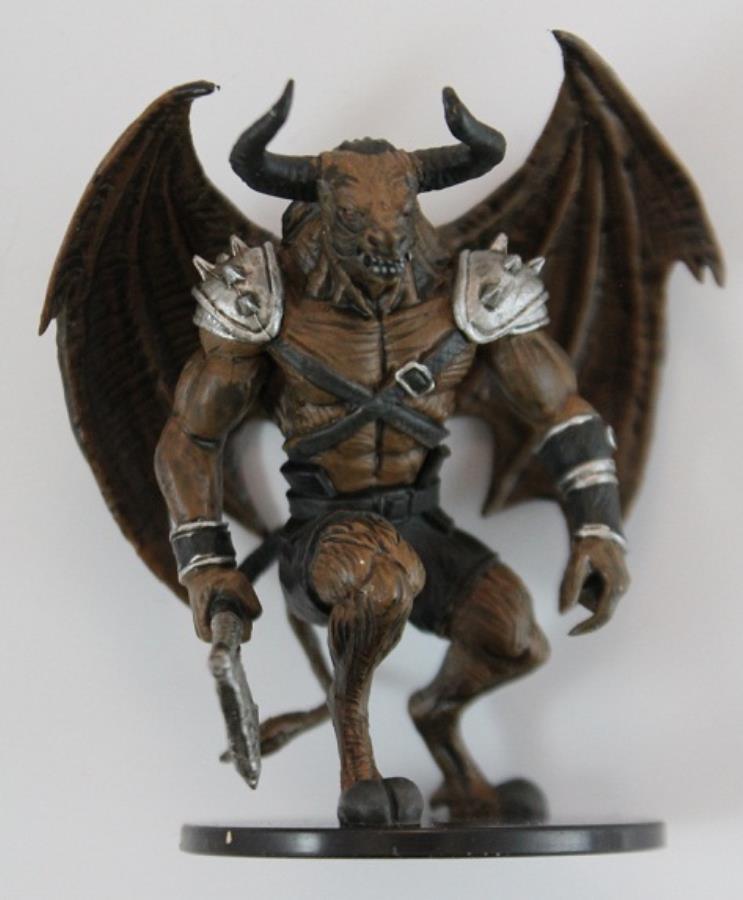This week, the Mighty Nein took the fight to the beguiling foes who had so long evaded them, and discovered that finding a fair fight against fiendish foes is easier said than done. They learned firsthand the power of charms and domination, so let’s learn how you can make being charmed fun for everyone as a player and as a Dungeon Master.

Art by Kayla Marquez (@OratorKayla)
Episode Summary
Previously on Critical Role, the Mighty Nein investigated Asarius, the City of Beasts, for other sources of demonic incursions. Eventually, their investigations led them to one of the city’s many wells. A pair of tempting fiends—a succubus and an incubus—greeted them within the well. The Mighty Nein fought bravely, and the fiends fled deeper into the well’s cavernous depths when the fight turned against them.
This week, the party delved deeper into the well. There, they encountered a group of quasits, scraping Abyssal sigils into the walls. This battle was quick and simple, for the quasits were no match for these warriors. After the quasits fell, Fjord investigated the walls and saw that these sigils were likely “anchor runes” that could open more Abyssal portals. Caleb cast a spell and wiped the walls clean, and the party moved on.
Nott cast invisibility and scouted ahead, with Caleb following close behind. However, while Nott continued unseen, Caleb was affected by a strange power—something that caused Matt to cross the table and whisper something long and complicated to him. When the rest of the party turned the corner, Caleb unleashed a 4th-level fireball at them all. The succubus had bent him to her will and commanded him to turn against his friends.
Scorched and confused, the Mighty Nein leapt into action. They fought frantically against Caleb, and he surrounded himself with a wall of fire. The succubus twisted his emotions into panic and antipathy, and he feared that his friends had finally turned against him. Yasha managed to close the gap and struck Caleb with her magic-dispelling greatsword, the Magician’s Judge, and broke the succubus’s grasp on Caleb’s mind. With Caleb free, the party once more turned their attention on the seductive demons, and battled them until they fled once more.
The party healed themselves for a moment and then pursued the succubus and incubus around the corner… then bore witness to a terrible sight.
The Mighty Nein watched in horror as an armanite trudged through the Abyssal portal. The pig-faced fiend assailed them with a crackling javelin of lightning while the succubus and incubus attempted to charm the adventurers and lead them to their doom. The two seductive fiends managed to bend Yasha to their will, but the succubus was still handily defeated, thanks in part to the wounds she incurred in the previous battle. Beau kept the hulking demon at bay with her Stunning Strikes for some time, but it eventually broke free and began to wreak havoc upon the party.
The fight was tense and saw several party members fall unconscious before Beau managed to deal the finishing blow. She shoved her fist into the armanite’s chest and plunged her arm deep into it until her fingers grasped its basketball-sized heart. She tightened her grip and tore the heart from its body as the pig-faced demon roared and frothed—and then fell still. Nott shot one final explosive arrow into the chest of the incubus, blasting him to giblets, but the collateral damage killed the already gravely wounded Caduceus. Fortunately, Jester had revivify in her back pocket, and cast it—consuming the diamond that she had previously wagered at the Four Corners—and brought Caduceus back.
The Mighty Nein decapitated the demon’s corpse and looted its corpse, and the chamber around it. A faint orange glow—like a bit of exposed, glowing glass. It was a silver disc, adorned with sigils, with a small glass orb filled with mercury. Four pieces of rough, pink crystals, wrapped in copper wire, were placed at the four corners of the disc. Jester identified the disc as an abyssal anchor, a tool that demonic generals used during the Calamity to punch holes between the Abyss and the Material Plane.

Art by Caio Santos (@BlackSalander)
Spotlight: Charms and Domination
Succubi and incubi have the potent ability to Charm their foes. Everyone needs to be on their game whenever spells or magical effects that remove player agency come into play. By forcing a player to obey the demands of a creature controlled by the DM, you are directly removing their ability to make meaningful choices—or are you?
I have three guidelines that I keep in mind when I use charm effects against my players:
- Read the text of the specific charm ability you’re using, and the text of the charmed condition.
- Give the player the ability to make choices within a constricting framework.
- Don’t use them on parties smaller than 4 players.
Matthew Mercer and I were on the same wavelength when it came to using charm effects, so let’s look at these three guidelines and, using examples from yesterday’s game, discuss how they can help you make charms and domination effects more fun in your own game.
Know Your Charms!
Every charm is different. A succubus has an action it can use called Charm, which it used against Caleb and Yasha to great effect last night. If the target creature fails its saving throw against this effect, they are charmed by the succubus. But that’s not all it does. Many different spells and effects ranging from charm person to dominate monster to a vampire’s Charm action bestow the charmed condition, but they all function somewhat differently.
Yes, despite their identical names and similar effects, a vampire’s Charm and a succubus’s Charm do have different effects. So if you play a succubus in one game and learn that its charm allows you to force one creature (and only one creature) to unerringly “[obey the succubus’s] verbal or telepathic commands,” then you might be in for a surprise the next day when you throw a vampire against your party. The vampire’s charm can affect as many creatures as it likes, though only one creature can be charmed per action—and this charm effect doesn’t force the vampire’s victims to unerringly follow its commands. Instead, the target “isn't under the vampire's control, [but] it takes the vampire's requests or actions in the most favorable way it can, and it is a willing target for the vampire's bite attack.”
The minor details of how any specific charm effect works can have major ramifications on the outcome of a battle, or even an entire session. So, don’t accidentally screw your players over (or let your players screw you over) by letting a charm monster spell duplicate the effects of the much more powerful dominate monster ! These moments of confusion are often honest mistakes, but even little mistakes can cause players or DMs to feel cheated once they realize what the “right way” actually was.
Restrict Agency, Don’t Remove Agency
Player agency is important. Put another way, we play games because we like to make choices with meaningful outcomes. It’s part of the power fantasy of D&D; our individual actions affecting meaningful change is a luxury we’re rarely afforded in the real world. So when you drop a charm effect on one of your players, you need to have a way to still allow them to make meaningful decisions, even though you’ve forced another being’s will upon them.
Matthew and Liam did this really well when Caleb was charmed, by digging into Caleb’s extant fear of betrayal and abandonment. The succubus may have commanded him to hurl a fireball at his friends, but once those friends retaliated, Caleb’s psychoses were guiding him as much as the succubus’s Charm was. Liam’s choices in combat from there on out where his own. The same could be said for Yasha, who always had a choice of who to attack in combat, unless Matthew decided the incubus wanted her to attack someone in particular.
A succubus’s Charm is actually a very restrictive charm effect. It’s almost as controlling as total domination, but even being controlled by another intelligence (such as with a dominate person spell, or being possessed by a ghost, or being replaced by a doppelganger) offers the dominated character some level of choice. In situations like this, it’s now the player’s job to fool their friends into thinking they’re still themselves. Liam clearly enjoyed himself when he did so in this episode. It takes a certain attitude—one of playing to have fun, not only playing to win—to enjoy this, and if you think one of your players won’t enjoy taking on this role, you might be better off using powers like these on a different player’s character.

Small Parties Beware
Charm effects are potent tools in combat because they not only remove an ally from the player’s side, they give an ally to the enemies’ side. Suddenly, the characters are not only down a fighter, but they have to spend their precious actions in combat trying to snap their friend out of their enchantment—all while that same friend is savagely attacking them!
It’s perfectly fine to charm or dominate a character in an average-size D&D party of 4 or 5. In a party as large as Critical Role’s, having a succubus and an incubus to potentially charm two characters at once is probably fine, too. But if you only have three characters in your party, removing even one character from their ranks reduces their fighting power by 33%. Do it in a party of two, and you’ve suddenly halved that party’s combat prowess.
If the charming enemy itself isn’t very strong (i.e., it’s otherwise an easy- or medium-difficulty encounter), then maybe you can introduce an enemy that charms one of the characters in a small party. Nevertheless, approach this situation with extreme caution. It’s one thing to revel in a “play for fun, not to win” mentality when everyone’s confident in their ability to succeed, and everyone’s close friends… but if your decision to charm or dominate a character ultimately leads to a total party kill and people blame the charmed character’s player for it, you’ve made a real mess of your group. Don’t put yourself or your players in that situation.
As always, these are just my suggestions. Hopefully, they help you develop your own way to make charming and magically dominating characters (or your DM’s monsters!) a fun experience for the whole party. So… is it Thursday yet?
Unless otherwise credited, photographs in this article are courtesy of Chris Lockey and Critical Role.
 James Haeck is the lead writer for D&D Beyond, the co-author of Waterdeep: Dragon Heist and the Critical Role Tal'Dorei Campaign Setting, the DM of Worlds Apart, and a freelance writer for Wizards of the Coast, the D&D Adventurers League, and Kobold Press. He loves watching Critical Role and wants everyone he knows to get into it, too. He lives in Seattle, Washington with his partner Hannah and his very own Frumpkins, Mei and Marzipan. You can usually find him wasting time on Twitter at @jamesjhaeck.
James Haeck is the lead writer for D&D Beyond, the co-author of Waterdeep: Dragon Heist and the Critical Role Tal'Dorei Campaign Setting, the DM of Worlds Apart, and a freelance writer for Wizards of the Coast, the D&D Adventurers League, and Kobold Press. He loves watching Critical Role and wants everyone he knows to get into it, too. He lives in Seattle, Washington with his partner Hannah and his very own Frumpkins, Mei and Marzipan. You can usually find him wasting time on Twitter at @jamesjhaeck.








-
View User Profile
-
Send Message
Posted Mar 15, 2019Do attacks that do force damage affect monsters who have the Etherealness action?
EDIT: I ask because of DMG p.48
-
View User Profile
-
Send Message
Posted Mar 15, 2019Damage type won't have any bearing, unless you have some other feature that allows you to affect beings on another plane or a way to get to the Ethereal Plane yourself. Matt was flavoring their ethereal form being visible, but in truth the Ethereal Plane is invisible to most.
-
View User Profile
-
Send Message
Posted Mar 15, 2019It was cute to watch The Mighty Nein get charmed for the first time. I get charmed/dominated all the time and end up PvPing the party more than I'd like to admit.
-
View User Profile
-
Send Message
Posted Mar 15, 2019On the topic of player agency, Sly Flourish tweeted a house rule a while back that I really like. When a character is stunned or paralyzed or otherwise denied participation in the round, considering offering the player the option to let the character "break out" of the condition, at least momentarily, at the cost of however much psychic damage. That way the player has the choice of whether to take the damage or give up their turn.
-
View User Profile
-
Send Message
Posted Mar 15, 2019I believe the demon they fought was not a Nalfeshnee, but a homebrew demon by Mercer. He said he put the stats up on DnD Beyond somewhere.
-
View User Profile
-
Send Message
Posted Mar 16, 2019I would like to see this demon. I agree, there's no way it was a Nalfeshnee. In fact, I'm fairly confident it's a homebrewed lesser version of a Balor.
-
View User Profile
-
Send Message
Posted Mar 16, 2019Homebrew based off the Armanite per Matt on twitter.
-
View User Profile
-
Send Message
Posted Mar 16, 2019Can we all take a minute and just think that if Jester didnt have that revivify Taliesin would've now lost 2 characters in this campaign.
-
View User Profile
-
Send Message
Posted Mar 16, 2019Was definitely not a nalfeshnee if it was they would have gotten walked over without a sweat at the point they started fighting it
-
View User Profile
-
Send Message
Posted Mar 17, 2019Is the Tal'Dorei Campaign Setting on D&D beyond?
-
View User Profile
-
Send Message
Posted Mar 17, 2019Keep these posts coming!
-
View User Profile
-
Send Message
Posted Mar 17, 2019Unfortunately, it is not, since it is published by Green Ronin Publishing. Only 1st-party and select 2nd-party (books officially licensed by D&D) appear on D&D Beyond.
-
View User Profile
-
Send Message
Posted Mar 18, 2019At one point the camera showed a view of the bottom of the mini for the big demon. It's a Half-Fiend Minotaur mini. (As seen above, the actual monster was a home brew based on the Armanite)

-
View User Profile
-
Send Message
Posted Mar 18, 2019Great catch! I'll modify the article text to reflect this.
-
View User Profile
-
Send Message
Posted Mar 19, 2019I haven't seen the last few episodes. When will they be available on YouTube?
-
View User Profile
-
Send Message
Posted Mar 19, 2019Be sure you're subscribed to the Critical Role YouTube channel, not the Geek & Sundry channel. The same goes for podcasts. As of a few weeks ago, Critical Role separated from G&S and Legendary Digital Networks and is now its own independent studio!
-
View User Profile
-
Send Message
Posted Mar 21, 2019I got to play as a simulacrum of myself in Dragon Heist and that was a lot of fun. Devil's sight mixed with a Darkness spell or Hunger of Hadar is a blast.
-
View User Profile
-
Send Message
Posted Mar 21, 2019Thanks. All caught up.
-
View User Profile
-
Send Message
Posted Mar 22, 2019The expressions and reactions from the cast, especially Liam, when he cast the fireball...the crew is amazing! And then later the look on Taliesin's face - he knew Jester had Revivify as Laura had mentioned it, but you could still see it in his face :)
Great episode, and I cannot wait for my Moon Druid to be "turned" like this one day and rip my party members to shreds :)
-
View User Profile
-
Send Message
Posted Mar 22, 2019I, at the time of writing this used a succubus yesterday at our game. 3 Players only this time. I just had the charm end after a round. So the fighter would do his thing, and then when his turn ended the charm ended.